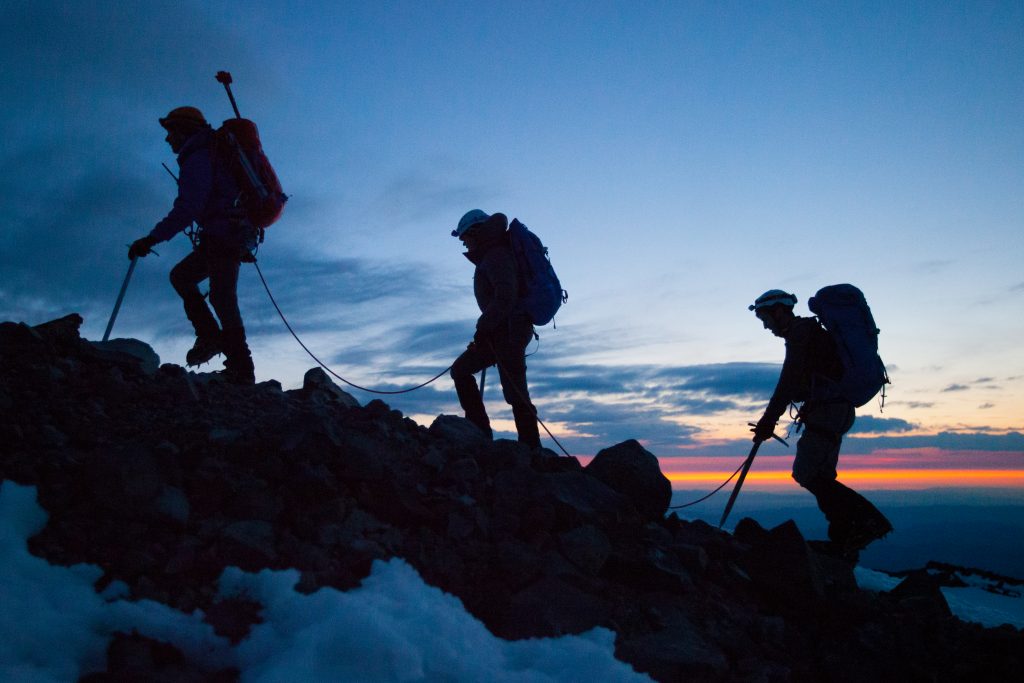After 4,000 feet of vertical gain, cresting over the crater rim of Mount St. Helens was way beyond my greatest expectations.
This trip was all very spontaneous. I had finished a great trip up Mount Whitney (from the west side, the only way to go) and was driving to Seattle when I intercepted some friends in Portland. The next thing I knew Ricky, Susannah and I were waking up, crammed in the bed of Susannah’s SUV in a lot at 3,700 feet. It was a beautiful clear day and we got an early start on the trail just as the sun started to crest over the ridgeline and reflected a warm glow on the trees to our east.
It was great to hiking in the Northwest again. I had spent the summer guiding in the White Mountains of New Hampshire, which are beautiful as well, but in a different way. Besides, the Cascades are where I grew up, and it’s hard to beat that sense of home. The cedar bows were just the right shade of green as the sunlight started to trickle through the thick canopy above. The trail wasn’t very steep, but it was steady. As we rounded a bend Mount Adams made a graceful entrance with the branches and evergreen canopy acting like curtains. Mount Adams and Mount Hood just behind us would keep us company for the rest of the climb.
Slowly, the trees started to thin out and around 4,500 feet we found ourselves walking along the east side of the rocky and gnarly terrain of an abandoned lateral moraine from when Mount St. Helens had glaciers flowing from its 12,000+ foot summit. With the trees still on our east side, we remained in the cool shade of their cover until the trail turned left into the aforementioned rock field and we started up the steep side of the red and black volcanic rock.
We were now just above 4,800 feet, where permits are required. Just below 4,800 feet there is a great trail that circumnavigates the whole mountain called the Loowit Trail. But we were going up and we were now above the trees and in the direct beams of the sun, still not very high in the sky. The wind from the west was gentle, but steady and it kept us plenty cool while were out on the exposed rock. There were a few hardy plants on this otherwise steep barren Martian landscape. Crouched away in small pockets of protection, there was one plant in particular with bright red leaves. It grew in small patches the size of a dinner plate and seemed to be hardier than most others because it could tolerate more exposed areas. But this plant looked like it was on fire! It just glowed. I was wearing my glacier goggles which have a blue blocker filter in them and that only emphasized the brilliance of the plant.
After climbing up the side of the moraine, we crested over to the west side of Monitor Ridge and continued up, due north, in the shade of the ridge. around 5,500 feet any evidence of the trail became sporadic at best. We found ourselves bouldering over, through and among large rocks and pulling ourselves hand over hand at times to continue the climb up. My little fire plant kept to the lower elevations as we pressed onward and upward. There were a few plateaus where the fine particles of ash, sand and pulverized pumice gathered and retained the footprints of those who climbed here before us.
We stopped here for a hydration break and a quick snack. The sun was now getting high in the sky but the elevation and the wind kept the temperatures at bay. Mount Adams and Mount Hood were still right there and it felt good to get our water-bottle laden packs off our backs. Jackets were required as the wind super cooled the moisture in our clothing. Now that we were finally above the low lying smog that is becoming more and more difficult to get away from, Mount Jefferson was starting to come into view way south of us.
“I was awestruck by the 1,500+ foot drop before me and by the width of the crater, which stretched over a mile wide…”
The rough terrain of the large boulders and climbing came to an end at 7,000 feet and we started on the loose ash and pumice. The slope was steep and we had to be sure our footing was secure before placing our full weight down. This was the home stretch and we had just over 1,000 feet to gain to the crest of the rim. Other climbers were starting to come down now. They were leaping and skipping down the loose hillside; it was as close to skiing as you could get on ash and pumice. They said the view was amazing and that we were almost there. Of course, ‘almost there’ was in perspective from their rapid gravity assisted flight down the slope. I tried to avoid saying the same thing to the few climbers going up that we saw on our way down late in the afternoon.
It was a slog. I found myself marching back and forth making my own switchbacks up the steep slope. Finally, I didn’t have to careen my neck all the way back to get a glimpse of the blue sky. I tried not to get too excited for fear that it was a false ridge, and I would crest it only to find more to climb. But as I got closer, the blue kept getting bigger. No slopes appeared beyond this ridge. The blue sky was nearly right in front of me, and then Mount Rainier, a mere 50 miles to the north appeared and the slope rounded out below my feet. My eyes kept falling and falling, quickly absorbing the terrain between Mount Rainier and the narrow crest of the rim where I stood. Then my eyes stopped me in my tracks as the steep cornice of the interior of the massive crater of Mount St. Helens opened up before me. I was awestruck by the 1,500+ foot drop before me and by the width of the crater, which stretched over a mile wide. The northern side of the crater, straight across from me, was completely gone and Spirit Lake, just through the gap in the crater, sparkled away in the high midday sun.
I was apprehensive to get too close to the inner rim of the crater, mostly because at first I couldn’t even see the slope! But after taking a moment to contemplate the unique view before me I moved ahead and was able to stand right on the edge of the rim and continue to take it all in.
We were at about 8,200 feet and this is where many stop and call it good enough. But Ricky, Susannah, and I would not be satisfied without taking the extra 20 minutes to hike along the very undulated crater rim to the highest point at 8,365 feet. The rim dropped back down another 100 feet from where we stood and then went back up. This drop was a bit of a scramble and the most precarious part of the whole climb, but well worth it. We finally reached the true summit and all celebrated together with summit photos, hoops and hollers. Susannah, who usually sticks with windsurfing and other water sports was very proud (and rightfully so) of her accomplishment. She commented that she now has one up on her sister who keeps talking about her hike up the 6,288 foot Mount Washington back east. She says she comes from a very competitive family of six girls, and getting here was defiantly something to write home about.
After the thrill of the summit abated, we pulled out a tarp and our lunch and leisurely consumed our victory feast. Just to the leeward side of the summit, there was a little five-foot dip where we were protected from the wind and Ricky and I were able to work on our tan.
After 45 minutes on the summit, we reluctantly packed up the remnant scraps of our lunch and made our way back around the rim, up the steep scramble, and then we skied and flew down the ash and pumice slope as the others had done before us. At 7,000 feet, when the big rocks started again, we had to stop and empty our boots of all the debris that snuck in while careening down the slope.
We made it back down to the SUV as the sun beams turned long again and we watched the color of the light evolve as it reflected off the mountain that now stood above us, the one we were just on the summit.
Written for MountainZone.com


